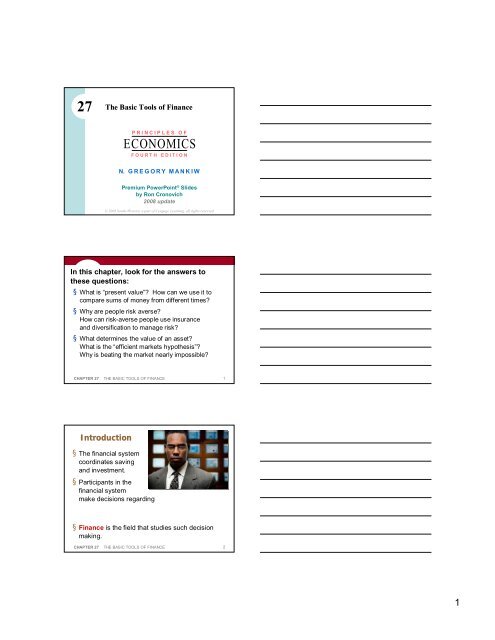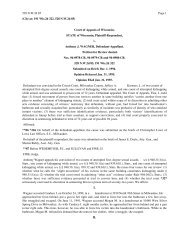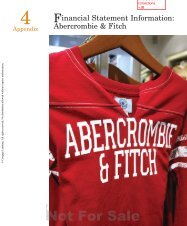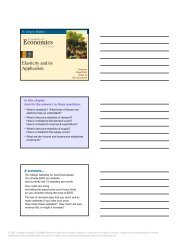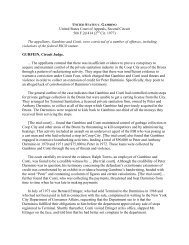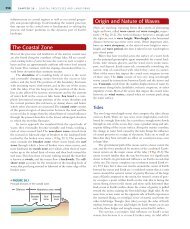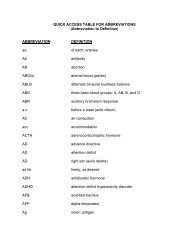27 - Cengage Learning
27 - Cengage Learning
27 - Cengage Learning
Create successful ePaper yourself
Turn your PDF publications into a flip-book with our unique Google optimized e-Paper software.
<strong>27</strong><br />
The Basic Tools of Finance<br />
P R I N C I P L E S O F<br />
ECONOMICS<br />
FOURTH EDITION<br />
N. GREGORY MANKIW<br />
Premium PowerPoint ® Slides<br />
by Ron Cronovich<br />
2008 update<br />
©2008 South-Western, a part of <strong>Cengage</strong> <strong>Learning</strong>, all rights reserved<br />
In this chapter, look for the answers to<br />
these questions:<br />
§ What is “present value”? How can we use it to<br />
compare sums of money from different times?<br />
§ Why are people risk averse?<br />
How can risk-averse people use insurance<br />
and diversification to manage risk?<br />
§ What determines the value of an asset?<br />
What is the “efficient markets hypothesis”?<br />
Why is beating the market nearly impossible?<br />
CHAPTER <strong>27</strong> THE BASIC TOOLS OF FINANCE 1<br />
Introduction<br />
§ The financial system<br />
coordinates saving<br />
and investment.<br />
§ Participants in the<br />
financial system<br />
make decisions regarding<br />
§ Finance is the field that studies such decision<br />
making.<br />
CHAPTER <strong>27</strong> THE BASIC TOOLS OF FINANCE 2<br />
1
Present Value: The Time Value of Money<br />
§ To compare a sums from different times, we use<br />
the concept of present value.<br />
§ The present value of a future sum:<br />
§ The future value of a sum:<br />
CHAPTER <strong>27</strong> THE BASIC TOOLS OF FINANCE 3<br />
EXAMPLE 1: A Simple Deposit<br />
§ Deposit $100 in the bank at 5% interest.<br />
What is the future value (FV) of this amount?<br />
§<br />
§ In three years, FV =<br />
§ In two years, FV =<br />
§ In one year, FV =<br />
CHAPTER <strong>27</strong> THE BASIC TOOLS OF FINANCE 4<br />
§ Deposit $100 in the bank at 5% interest.<br />
What is the future value (FV) of this amount?<br />
§ In N years, FV = $100(1 + 0.05) N<br />
§ In this example, $100 is the present value (PV).<br />
§ In general,<br />
EXAMPLE 1: A Simple Deposit<br />
where r denotes the interest rate (in decimal form).<br />
§ Solve for PV to get:<br />
CHAPTER <strong>27</strong> THE BASIC TOOLS OF FINANCE 5<br />
2
EXAMPLE 2: Investment Decision<br />
Present value formula: PV = FV/(1 + r ) N<br />
Present value formula: PV = FV/(1 + r ) N<br />
§ Suppose r = 0.06.<br />
Should General Motors spend $100 million to<br />
build a factory that will yield $200 million in ten<br />
years?<br />
Solution:<br />
CHAPTER <strong>27</strong> THE BASIC TOOLS OF FINANCE 6<br />
EXAMPLE 2: Investment Decision<br />
§ Instead, suppose r = 0.09.<br />
Should General Motors spend $100 million to<br />
build a factory that will yield $200 million in ten<br />
years?<br />
Solution:<br />
present value helps explain why<br />
CHAPTER <strong>27</strong> THE BASIC TOOLS OF FINANCE 7<br />
A C T I V E L E A R N I N G 1: :<br />
Present value<br />
You are thinking of buying a six-acre lot for $70,000.<br />
The lot will be worth $100,000 in 5 years.<br />
A. Should you buy the lot if r = 0.05?<br />
B. Should you buy it if r = 0.10?<br />
8<br />
3
§ Compounding:<br />
Compounding<br />
§ Because of compounding, small differences in<br />
interest rates lead to big differences over time.<br />
§ Example: Buy $1000 worth of Microsoft stock,<br />
hold for 30 years.<br />
If rate of return = 0.08, FV = $10,063<br />
If rate of return = 0.10, FV = $17,450<br />
CHAPTER <strong>27</strong> THE BASIC TOOLS OF FINANCE 10<br />
§ The Rule of 70:<br />
The Rule of 70<br />
§ Example:<br />
• If interest rate is 5%, a deposit will double in<br />
• If interest rate is 7%, a deposit will double in<br />
CHAPTER <strong>27</strong> THE BASIC TOOLS OF FINANCE 11<br />
Risk Aversion<br />
§ Most people are risk averse –they dislike<br />
uncertainty.<br />
§ Example: You are offered the following gamble.<br />
Toss a fair coin.<br />
• If heads, you win $1000.<br />
• If tails, you lose $1000.<br />
Should you take this gamble?<br />
§ If you are risk averse,<br />
CHAPTER <strong>27</strong> THE BASIC TOOLS OF FINANCE 12<br />
4
The Utility Function and Risk Aversion<br />
Utility<br />
Wealth<br />
CHAPTER <strong>27</strong> THE BASIC TOOLS OF FINANCE 14<br />
Managing Risk With Insurance<br />
§ How insurance works:<br />
A person facing a risk pays a fee to the<br />
insurance company, which in return accepts<br />
part or all of the risk.<br />
§<br />
E.g., it is easier for 10,000 people to each bear<br />
1/10,000 of the risk of a house burning down<br />
than for one person to bear the entire risk alone.<br />
CHAPTER <strong>27</strong> THE BASIC TOOLS OF FINANCE 15<br />
Two Problems in Insurance Markets<br />
1. Adverse selection:<br />
2. Moral hazard:<br />
Insurance companies cannot fully guard against<br />
these problems, so they must charge higher prices.<br />
As a result,<br />
CHAPTER <strong>27</strong> THE BASIC TOOLS OF FINANCE 16<br />
5
A C T I V E L E A R N I N G 2: :<br />
Adverse selection or moral hazard?<br />
Identify whether each of the following is an example of<br />
adverse selection or moral hazard.<br />
A. Joe begins smoking in bed after buying fire<br />
insurance.<br />
B. Both of Susan’s parents lost their teeth to gum<br />
disease, so Susan buys dental insurance.<br />
C. When Gertrude parks her Corvette convertible,<br />
she doesn’t bother putting the top up, because her<br />
insurance covers theft of any items left in the car.<br />
Measuring Risk<br />
§ We can measure risk of an asset with the<br />
standard deviation, a statistic that measures<br />
§ The higher the standard deviation of the asset’s<br />
return,<br />
CHAPTER <strong>27</strong> THE BASIC TOOLS OF FINANCE 19<br />
Reducing Risk Through Diversification<br />
§ Diversification<br />
§ A diversified portfolio contains assets whose<br />
returns are not strongly related:<br />
• Some assets will realize high returns,<br />
others low returns.<br />
•<br />
CHAPTER <strong>27</strong> THE BASIC TOOLS OF FINANCE 20<br />
17<br />
6
Reducing Risk Through Diversification<br />
§ Diversification can reduce<br />
§ Diversification cannot reduce<br />
CHAPTER <strong>27</strong> THE BASIC TOOLS OF FINANCE 21<br />
Standard dev of<br />
portfolio return<br />
Reducing Risk Through Diversification<br />
50<br />
40<br />
30<br />
20<br />
10<br />
0<br />
0 10 20 30 40<br />
# of stocks in portfolio<br />
CHAPTER <strong>27</strong> THE BASIC TOOLS OF FINANCE 22<br />
The Tradeoff Between Risk and Return<br />
§ One of the Ten Principles from Chapter 1:<br />
People face tradeoffs.<br />
§ A tradeoff between risk and return:<br />
§ E.g., over past 200 years, average real return on<br />
stocks, 8%. On short-term govt bonds, 3%.<br />
CHAPTER <strong>27</strong> THE BASIC TOOLS OF FINANCE 23<br />
7
The Tradeoff Between Risk and Return<br />
§ Example:<br />
Suppose you are dividing your portfolio between<br />
two asset classes.<br />
• A diversified group of risky stocks:<br />
average return = 8%, standard dev. = 20%<br />
• A safe asset:<br />
return = 3%, standard dev. = 0%<br />
§ The risk and return on the portfolio depends on the<br />
percentage of each asset class in the portfolio…<br />
CHAPTER <strong>27</strong> THE BASIC TOOLS OF FINANCE 24<br />
The Tradeoff Between Risk and Return<br />
CHAPTER <strong>27</strong> THE BASIC TOOLS OF FINANCE 25<br />
Asset Valuation<br />
§ When deciding whether to buy a company’s stock,<br />
you compare the price of the shares to<br />
the value of the company.<br />
• If share price > value, the stock is<br />
• If price < value, the stock is<br />
• If price = value, the stock is<br />
CHAPTER <strong>27</strong> THE BASIC TOOLS OF FINANCE 26<br />
8
A C T I V E L E A R N I N G 3: :<br />
Valuing a share of stock<br />
If you buy a share of AT&T stock today,<br />
• you will be able to sell it in 3 years for $30<br />
• you will receive a $1 dividend at the end of<br />
each of those 3 years<br />
If the prevailing interest rate is 10%,<br />
what is the value of a share of AT&T stock today?<br />
A C T I V E L E A R N I N G 3: :<br />
Answers<br />
§ Value of a share =<br />
Asset Valuation<br />
§ Problem: When you buy the share, you don’t<br />
know what future dividends or prices will be.<br />
§ One way to value a stock:<br />
CHAPTER <strong>27</strong> THE BASIC TOOLS OF FINANCE 29<br />
<strong>27</strong><br />
28<br />
9
A C T I V E L E A R N I N G 4: :<br />
Show-of Show of-hands hands survey<br />
You have a brokerage account with Merrill Lynch.<br />
Your broker calls you with a hot tip about a stock:<br />
new information suggests that the company will be<br />
highly profitable.<br />
Should you buy stock in the company?<br />
A. Yes<br />
B. No<br />
C. Not until you read the prospectus.<br />
D. What’s a prospectus?<br />
The Efficient Markets Hypothesis<br />
§ Efficient Markets Hypothesis (EMH):<br />
CHAPTER <strong>27</strong> THE BASIC TOOLS OF FINANCE 31<br />
Implications of EMH<br />
1. Stock market is informationally efficient:<br />
2. Stock prices follow a random walk:<br />
3.<br />
CHAPTER <strong>27</strong> THE BASIC TOOLS OF FINANCE 32<br />
30<br />
10
Index Funds vs. Managed Funds<br />
§ An index fund is<br />
§ An actively managed mutual fund aims to buy<br />
only the best stocks.<br />
§ Actively managed funds have higher expenses<br />
than index funds.<br />
§ EMH implies that<br />
CHAPTER <strong>27</strong> THE BASIC TOOLS OF FINANCE 33<br />
Index Funds vs. Managed Funds<br />
S&P 500 (index fund)<br />
Managed large cap funds<br />
S&P MidCap 400 (index fund)<br />
Managed mid cap funds<br />
S&P SmallCap 600 (index fund)<br />
Managed mid cap funds<br />
2001-2006<br />
annualized<br />
return<br />
6.2%<br />
5.9<br />
10.9<br />
8.1<br />
12.5<br />
10.3<br />
2006<br />
expense<br />
ratio<br />
.351<br />
1.020<br />
.535<br />
1.458<br />
.550<br />
1.<strong>27</strong>2<br />
CHAPTER <strong>27</strong> THE BASIC TOOLS OF FINANCE 34<br />
Market Irrationality<br />
§ Many believe that stock price movements are<br />
partly psychological:<br />
• J.M. Keynes: stock prices driven by “animal<br />
spirits,” “waves of pessimism and optimism”<br />
• Alan Greenspan: 1990s stock market boom due<br />
to “irrational exuberance”<br />
§ Bubbles<br />
§ The importance of departures from rational<br />
pricing is not known.<br />
CHAPTER <strong>27</strong> THE BASIC TOOLS OF FINANCE 35<br />
11
CONCLUSION<br />
§ This chapter has introduced some of the basic<br />
tools people use when they make financial<br />
decisions.<br />
§ The efficient markets hypothesis teaches that a<br />
stock price should reflect the company’s<br />
expected future profitability.<br />
§ Fluctuations in the stock market have important<br />
macroeconomic implications, which we will study<br />
later in this course.<br />
CHAPTER <strong>27</strong> THE BASIC TOOLS OF FINANCE 36<br />
12


